In thi Kit:
- Book Summary Page (in printable kit)
- Main Characters Page (in printable kit)
- Discussion Questions Page (in printable kit)
- Book Quotes Page (in printable kit)
- Icebreaker Up From the Dust with Giraffes Game (printable kit only)
- About the Author Page (in printable kit)
- Historical Facts Surrounding this Book (in printable kit)
- List of Podcasts and Videos about this Book
- Meeting Decoration Ideas (in printable kit)
- Meeting Decorations Printable Images (printable kit only)
- Meeting Menu Ideas (in printable kit)
- Meeting Food Recipes (in printable kit only)
- Bookmarks for West with Giraffes (in printable kit only)
- Bookmarks for Readers With Wrinkles (in printable kit only)

West with Giraffes by Lynda Rutledge is a historical fiction novel inspired by the true story of two giraffes' journey across Depression-era America in 1938. The narrative is framed by Woodrow Wilson Nickel (“Woody”), a 105-year-old WWII veteran, who, in 2025, recounts his memories of the twelve-day road trip that changed his life.
Plot Summary
The story begins with Woody, a 17-year-old orphan from Texas, surviving the catastrophic New York Harbor hurricane of 1938. He joins Riley Jones, a seasoned zookeeper, to transport two giraffes—nicknamed "Boy" and "Girl"—from New York to the San Diego Zoo on a modified flatbed truck.
Along the way, Woody and Riley encounter numerous challenges, including treacherous roads, animal rights conflicts, and oppressive racism. Woody also grapples with his traumatic past and his guilt over the death of his family.
They are accompanied by Augusta Lowe, "Red," an aspiring photographer documenting the journey. Red's interactions with Woody spark a romantic subplot while revealing her own struggles as a runaway wife.
Themes and Character Development
The novel explores themes of resilience, redemption, and the transformative power of animals. Woody grows from a desperate orphan into a young man who learns to confront his fears and embrace his future.
The giraffes symbolize grace and survival, inspiring both Woody and Riley to overcome their personal demons during the arduous journey.
Historical Context
Set against the backdrop of the Great Depression and Dust Bowl, the novel vividly portrays America’s struggles during this era while highlighting acts of kindness from strangers amidst adversity.
West with Giraffes combines adventure, historical drama, and coming-of-age elements into an emotional tale that celebrates endurance and hope.

Woodrow Wilson Nickel (Woody)
The protagonist and narrator, Woody is a 17-year-old orphan from the Dust Bowl who embarks on a life-changing journey to transport two giraffes across America. His narrative blends youthful energy with the wisdom of his older self, reflecting on the events of 1938.
Riley Jones (Old Man)
The head keeper of the San Diego Zoo and the man in charge of the giraffes’ cross-country journey. Described as a "leathery old man with a face like a mule," Riley is compassionate and determined, guiding Woody and ensuring the safe transport of the giraffes.
Augusta Lowe (Red)
A spirited photographer aspiring to work for Life magazine, Red documents the giraffes’ journey. She is a central figure in Woody’s adventure, adding depth to the narrative through her ambition and relationship with her husband, Lionel.
Wild Boy and Wild Girl (Lofty and Patches)
The two giraffes at the heart of the story, symbolizing hope and the bond between humans and nature. Their presence transforms the lives of those who encounter them, including Woody.
Earl
The initial driver of the journey, whose abrupt departure sets the stage for Woody’s unexpected role in the adventure.
Lionel Abraham Lowe
Red’s husband and a reporter, Lionel’s background and relationship with Red add layers to her character and motivations.
Augie Ann
The daughter of Red and Lionel, Augie Ann serves as a symbolic bridge between the past and present, linking the historical journey to the future.
Mr. Jackson (Big Papa)
The patriarch of a family that offers shelter to Woody and the giraffes. His character provides insight into the racial dynamics of the time and the kindness that transcends societal barriers.
Moses
Big Papa’s eldest son, whose curiosity and wonder upon seeing the giraffes underscore their universal appeal.
Percival T Bowles
Circus ringmaster
Cooter
Animal abuser who owns a run-down roadside desert animal attraction
These characters collectively enrich the narrative of West With Giraffes, each contributing to the themes of survival, transformation, and the enduring connection between humans and animals.

The following discussion questions are numbered and correspond to the numered locations along the giraffe transport route. Each question can be printed on a separate piece of paper and handed out to each attending member of the club. Then the discussion can progress, and each member that has his/her given number can read the question to spur discussion.
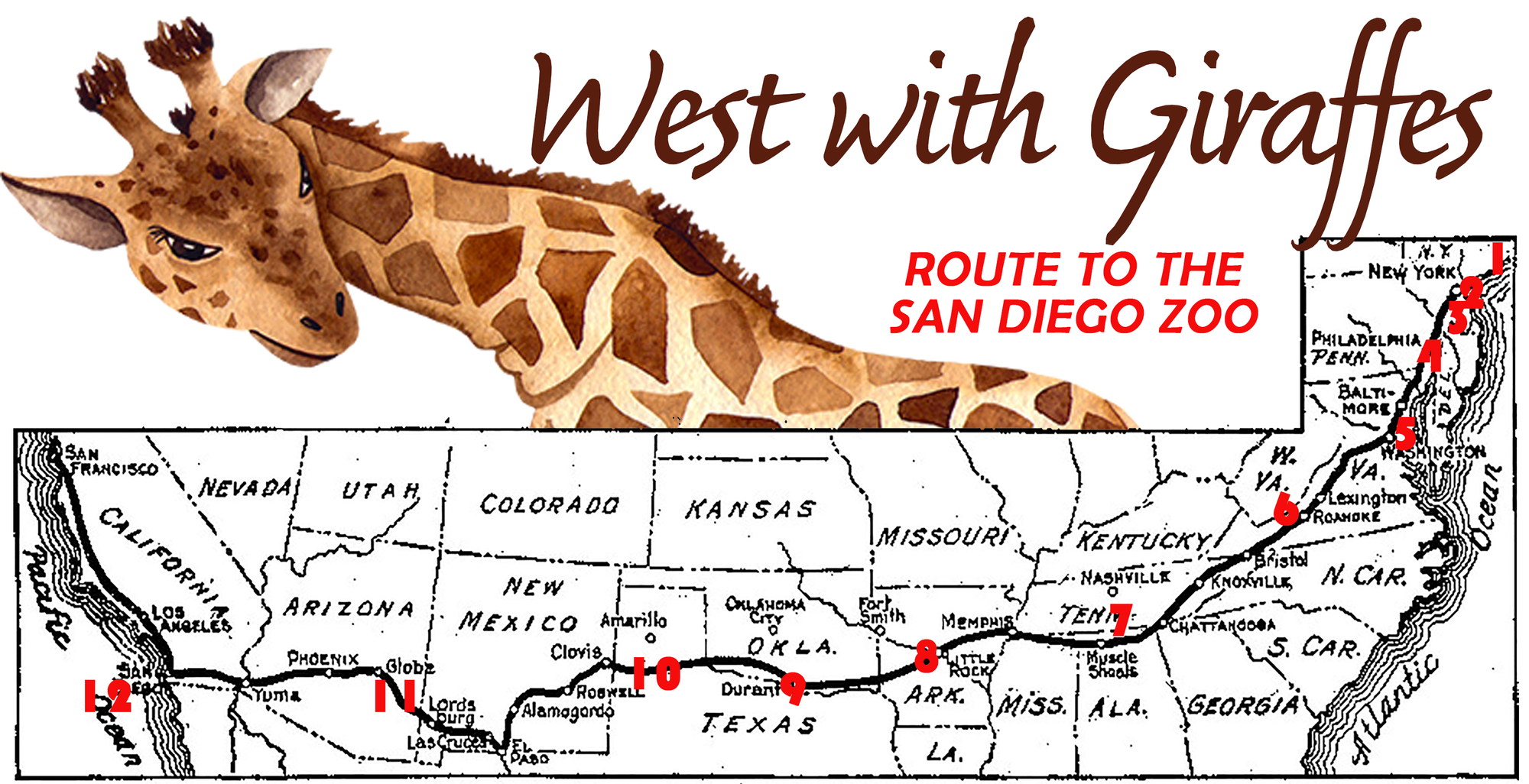
- New York - Hurricane - Start of Road Trip
Have you ever dreamed of taking or have you taken a driving trip cross-country? If you have, what were the highlights for you? What did you discover in the expanse of your country? What did you learn about your traveling companions, and what did they learn about you? - New Jersey - Quarantine Station
There are many things we don't know about the Old Man's past. Why do you think the author didn't provide more about his backstory? If you could ask him one question about his past, what would you most want to know? - Massachusetts - Earl, the driver, leaves
Red is the young reporter who follows the giraffe truck across the country. She is married to a much older man, and Woody is just beginning his life, although they are close in age. Do you think their lives are as different as they seem on the surface? Could they have built a relationship and a life together under different circumstances? Red had a "Things I'm Doing Before I Die" list that included four famous women that she wanted to meet. How did this list shape her as a character? Do you have a bucket list, and if so, what's on your list? - Maryland - Woody gets new clothes
How would this story have been different if it had only been told from the 1938 perspective? Discuss the storytelling technique of having Woody write his story down many years later. - Washington, D.C. - Woody continues the trip; is not sent home
Why do you think Riley Jones agreed to give Woody a chance at the beginning of the story? Why did he continue to give him second chances? - Smokey Mountains - rig is almost lost with treachery of the mountains
Who did you think was the “you” that Woody was addressing as he wrote in his notebooks? How did you feel when you found out? How do you think “you” reacted after receiving the notebooks? - Tennessee - African American camp
Discuss the racial issues in the book. How did Woody’s perspective change after meeting the Jackson family? - Little Rock, Arkansas - new zoo provides medication for the darlings
One of the real-life characters is Belle Benchley, the woman director of the San Diego Zoo. Although she ran the zoo for years, her title remained “Secretary” due to sexist ideas about what jobs women could do. Were you surprised to read that the (male) zookeepers loved her? Were you surprised by the remarks made about women driving alone and other sexist attitudes of 1938? We’ve come a long way, ladies! - Oklahoma - the entourage encounters the traveling circus
Zoos are somewhat controversial for their methods, criticized for keeping animals in cages but appreciated for preserving endangered species. What do you think about zoos, both then and now? Do you think that in the 1930s a zoo was a better environment for animals than a circus? Do you have strong opinions about zoos and circuses? What do you think the author’s opinion is and do you have evidence to support your conclusion? Discuss how the role of zoos and their treatment of animals have changed over the past century. - Texas - Woody deals with his past in Texas
One poignant theme is the idea of “home.” Returning home. Avoiding home. Facing memories of home. Developing a new definition of home. How have you experienced the concept of home? - New Mexico/Arizona - animal sideshow show encounter
We all know the saying “don’t judge a book by its cover,” but let’s be honest – many of us do. What was your first impression of this book based on the cover? Take a look at the alternate covers from different countries and discuss how your first impression might have been different and which cover you think best represents the book. - San Diego - the darlings find a home
Woody says that he’s had few true friends, but that Wild Boy and Wild Girl were two of them. Do you think that humans and animals are capable of true friendship? Have you experienced this level of friendship with an animal?


Lynda Rutledge is a professional writer with over 25 years of experience, known for her work as a copywriter, restaurant and film reviewer, book collaborator, nonfiction author, travel writer, and freelance journalist. Her articles have appeared in publications such as the Chicago Tribune, Chicago Sun-Times, and San Diego Union-Tribune, often accompanied by her travel photographs.
Rutledge is the author of West with Giraffes, a historical novel inspired by the true story of two giraffes that survived a hurricane while crossing the Atlantic in 1938 and were transported to the San Diego Zoo. Her latest book, released last year, Mockingbird Summer, is semi-autobiographical and explores themes of hope and friendship in a small Texas town during 1964.
Rutledge holds an MFA in creative writing and degrees in American literature, and has received awards and residencies from organizations such as the Illinois Arts Council and the Writers League of Texas. Rutledge’s debut novel, Faith Bass Darling’s Last Garage Sale, was published in 2012 and later adapted into a French film. Her writing is often influenced by her extensive life experiences, including adventures like hang-gliding in Switzerland and snorkeling with sea turtles.

“Until one has loved an animal, a part of one’s soul remains unawakened.” – Anatole France, Nobel Laureate, 1921 (quoted in the epilogue
“People look at you peculiar if you talk about the feeling you got for animals, saying animals have no souls, no sense of good or bad, no value up next to humans," he said. "I don't know about that. Sometimes I think animals are the ones who should be saying such things about us."
He shook his head. "Animals can tear your heart out. They can maim you. They can kill you dead on instinct alone and saunter into the next minute like it was nothing. But at least you know the ground rules with animals. You can count the cost of breaking the rules. You never know with people. Even the good can hurt you bad, and the bad, well, they're going to hurt you but good." He dropped his arm from the window to rub his gnarled hand. "It's why I keep choosing animals. Even if it kills me. One day, it probably will.”
“In a long life, there is a singular moment when you know you’ve made more memories than any new ones you’ll ever make.”
“Sometimes, the greatest journeys are the ones that lead us to ourselves.”
“There is magic in the world, if only we choose to see it, and allow ourselves to be enchanted by it.”
“It’s a strange thing how you can spend years with some folks and never know them, yet, with others, you only need a handful of days to know them far beyond years.”
“She had red curls all over her head, a fiery halo of raging waves she surely battled into submission every morning.”
“Embrace your individuality, for it is what sets you apart and makes you truly extraordinary.”
“Despite those things happening to the Dust Bowl boy I was only days before, I didn’t feel much like that boy
“In a world that tries to confine us, dare to be different, dare to be a giraffe among the sheep.”
“It is a foolish man who thinks stories do not matter — when in the end, they may be all that matter and all the forever we’ll ever know.”
“The first time a poor soul gets a bit of grace in his wretched life, especially from a man who, by his own pronouncements, abides no chicanery, it’s a hard thing to recognize let alone accept, and even harder to trust.”
“I knew what to do with judgment, having a young lifetime of experience with that. This level of kindness, though, if kindness it be, only made me prickly and even a bit fearful.”
"Sometimes, the most meaningful connections are formed between beings that are seemingly worlds apart.
“Few true friends I have known and two were giraffes….”
“The land you grow up in is a forever thing, remembered when all else is forgotten, whether it did you right or did you wrong.”
“Home’s not the place you’re from, Woody. Home’s the place you want to be.”
The rig, the Old Man, and the giraffes were more home–and more family–than any home I’d ever had.”


The True Story Behind West With Giraffes
West with Giraffes is based on the true story of two giraffes that were transported across the US en route to the San Diego Zoo in 1938.
Few zoos at the time had giraffes, and keeping them was very expensive. But the San Diego Zoo, under the leadership of Belle Benchley, the world's first female zoo director, was good at fundraising and known for taking risks. She arranged for two giraffes from Uganda to be transported to the U.S. by way of a 52-day transatlantic crossing on the S.S. Robin Goodfellow.
During the final days of the trip, the ship encountered what was, at the time, one of the most devastating hurricanes to hit the upper East Coast. New York didn't see another hurricane this destructive until Hurricane Sandy hit in 2012. The 1938 hurricane killed nearly 700 people, but somehow the giraffes survived aboard the ship.
Once they reached New York, Belle assigned a zookeeper by the name of Charley Smith to transport the giraffes across the country from New York to San Diego. The character of Riley Jones is loosely based on Charley, although author Lynda Rutledge took creative license regarding the events of the journey because Charley did not keep a journal, and little is known beyond what was reported in newspapers.
When the giraffes arrived in the dock in Brooklyn, the female giraffe had a severely injured ankle, so Belle arranged for a veterinarian from the Bronx Zoo to examine and treat the injury. Once the vet determined that it was safe for her to travel, both giraffes were transported to an animal quarantine station in New Jersey, where they were held for 15 days. Smith stayed with the animals throughout this time, sleeping beside their stalls and tending the female giraffe's injury.
Belle had to decide whether to transport the giraffes across the country by train or by truck. While giraffes had never been driven across the country before, Belle determined this was the better option because it allowed the freedom to stop as often as necessary for the animals to rest and eat.
The giraffes were loaded into custom-made, 128" tall, padded travel crates with room for the giraffes to lie down on beds of peat moss and straw. Then the crates were loaded onto the back of a pickup truck, and the journey west began on October 10, 1938. Charley sent occasional telegrams to Belle as they made their way across the country, but according to her memoir, he shared few details.
Upon reaching the San Diego Zoo, the giraffes were given the names Lofty and Patches. They lived there for 30 years, during which time they had seven offspring.

Here are some podcasts that discuss Lynda Rutledge's West with Giraffes:
- The Reading Cove Book Club—Episode 131
This podcast features a discussion among members Roberta, Monica, and Millenia about West with Giraffes. They share their thoughts on the novel, which was a Cove pick for October 2021. Spoiler warning applies for this episode.
- The Literary City: The Compelling Prose of Lynda Rutledge
This episode dives into the prose of Lynda Rutledge and explores the themes and storytelling in West with Giraffes. It was released on February 21,
- Life and Lit Podcast—Episode 89: Heading West with Giraffes
Hosts Sydney and Paige discuss West with Giraffes as part of their historical fiction focus, rounding out February with this book.
- The Natural Curiosity Project—Episode 258: Thoughts on the Past and Future
This episode reflects on West with Giraffes, discussing its historical context and broader implications for the past and future.
- SoundCloud Discussion—Amy and Sue
Amy and Sue talk about West with Giraffes as a "hidden gem" of historical fiction, focusing on its unique journey across the U.S. - The Reading Lounge Podcast
This podcast explores the story inspired by true events, focusing on the journey of giraffes and their caretaker across the country.


Set the Table
- Use giraffe-themed paper goods like plates, napkins, and bamboo appetizer forks to create a playful yet sophisticated atmosphere.
- Consider vintage-style toy trucks with toy giraffe figurines in the bed as a centerpiece to evoke the cross-country road trip theme.
- Display a laminated vintage-style US map to trace the route traveled in the book or highlight key locations discussed. (included in printable kit)

Centerpiece Ideas
- Create a striking centerpiece with a giant giraffe cardboard cutout, which can also be reused for future gatherings
- For a simpler option, arrange giraffe figurines or Burma Shave ads to reflect the 1930s roadside aesthetic.
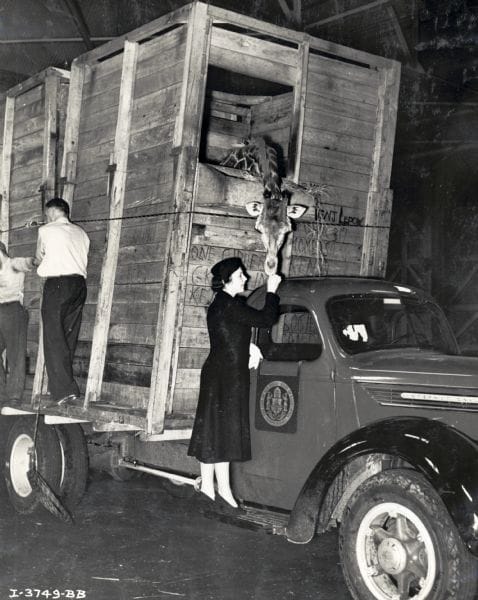
Wall Decor
- Hang copies of LIFE magazine featuring giraffes on the cover or other historical images related to the story.
- Use giraffe-themed stickers to decorate wine bottles or other items, adding a subtle nod to the book’s theme.
Interactive Elements
- Provide a map for members to track the reading progress along the giraffes’ route, or use an interactive online map for a group activity. (Included in printable Book Club Kit)
- Up From the Dust with Giraffes Game: A great way to begin your meeting and get members "in the mood" for the book discussion. This game is included with the printable Book Club Kit
- Provide West with Giraffes bookmarks to members as well as onions as parting gifts. The bookmark template is included with the printable Book Club Kit.

Here are some themed refreshment ideas for a West with Giraffes book club meeting, inspired by the novel’s 1930s roadside diner setting and its unique giraffe-centric storyline:

Appetizers
- Onion Rings: A nod to the giraffes’ fondness for onions and the diner theme. Serve with a beer-based batter for authenticity.
- Veggie Kebabs: Include a mix of vegetables like carrots, celery, and cherry tomatoes, reflecting the giraffes’ diet.
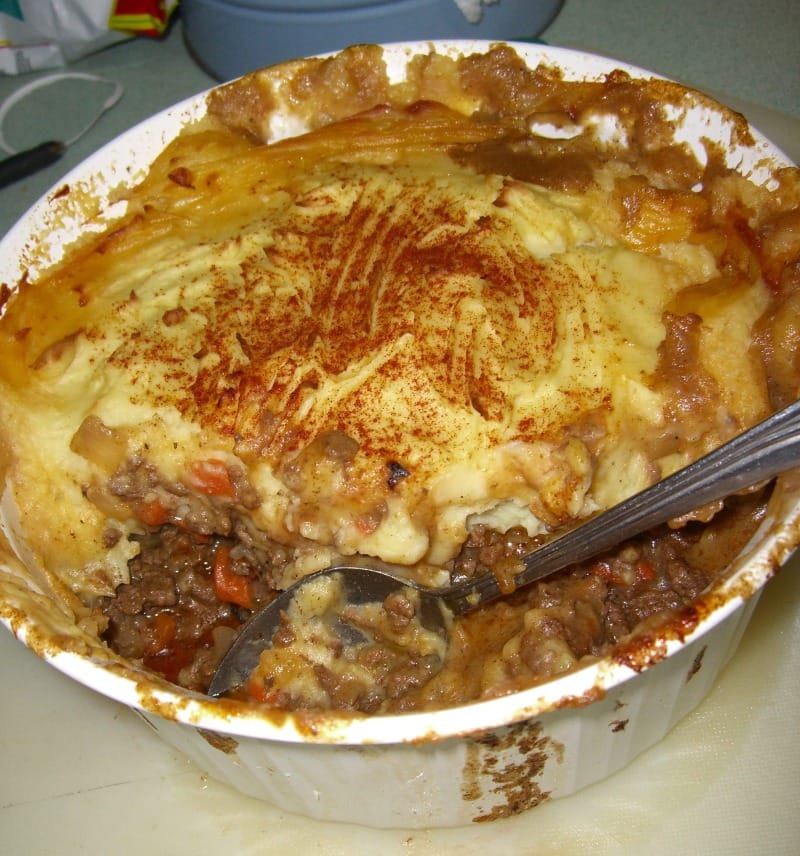
Main Course
- Shepherd’s Pie: A hearty meat pie with a potato topping, reminiscent of the comfort food mentioned in the book.
- Mini Hamburgers: A classic diner staple, perfect for capturing the roadside stop vibe.

Desserts
- Coconut Pound Cake: Inspired by the coconut cake enjoyed by Woody and Mr. Jones during their journey.
- Fruit Pie: A diner classic, such as apple or cherry pie, to round out the meal.
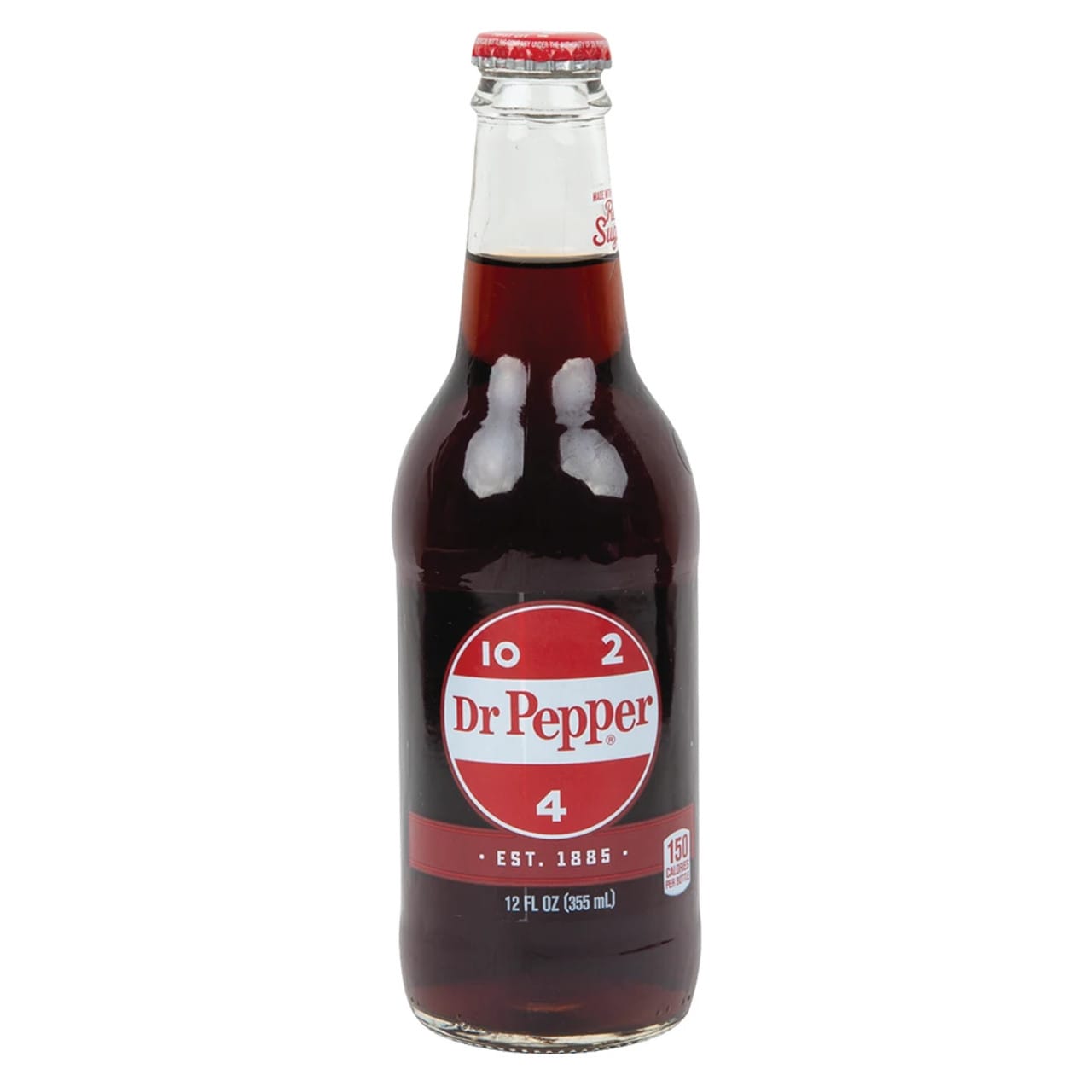

Beverages
- Dr. Pepper or RC Cola: Serve in glass bottles for a nostalgic touch, as mentioned in the book.
- Sarsaparilla: A unique option to evoke the 1930s atmosphere.
- Coffee or Coffee Cocktails: Pair with Bailey’s Irish Cream for a comforting twist.
Recipes are included in the printable Book Club Kit.

West with Giraffes printable BOOK CLUB KIT
The RWW book club kits provide everything you need to organize a great meeting with insightful discussions. These resources simplify book club preparation with character lists, book quotes, refreshment suggestions, recipes, and carefully prepared book club questions!
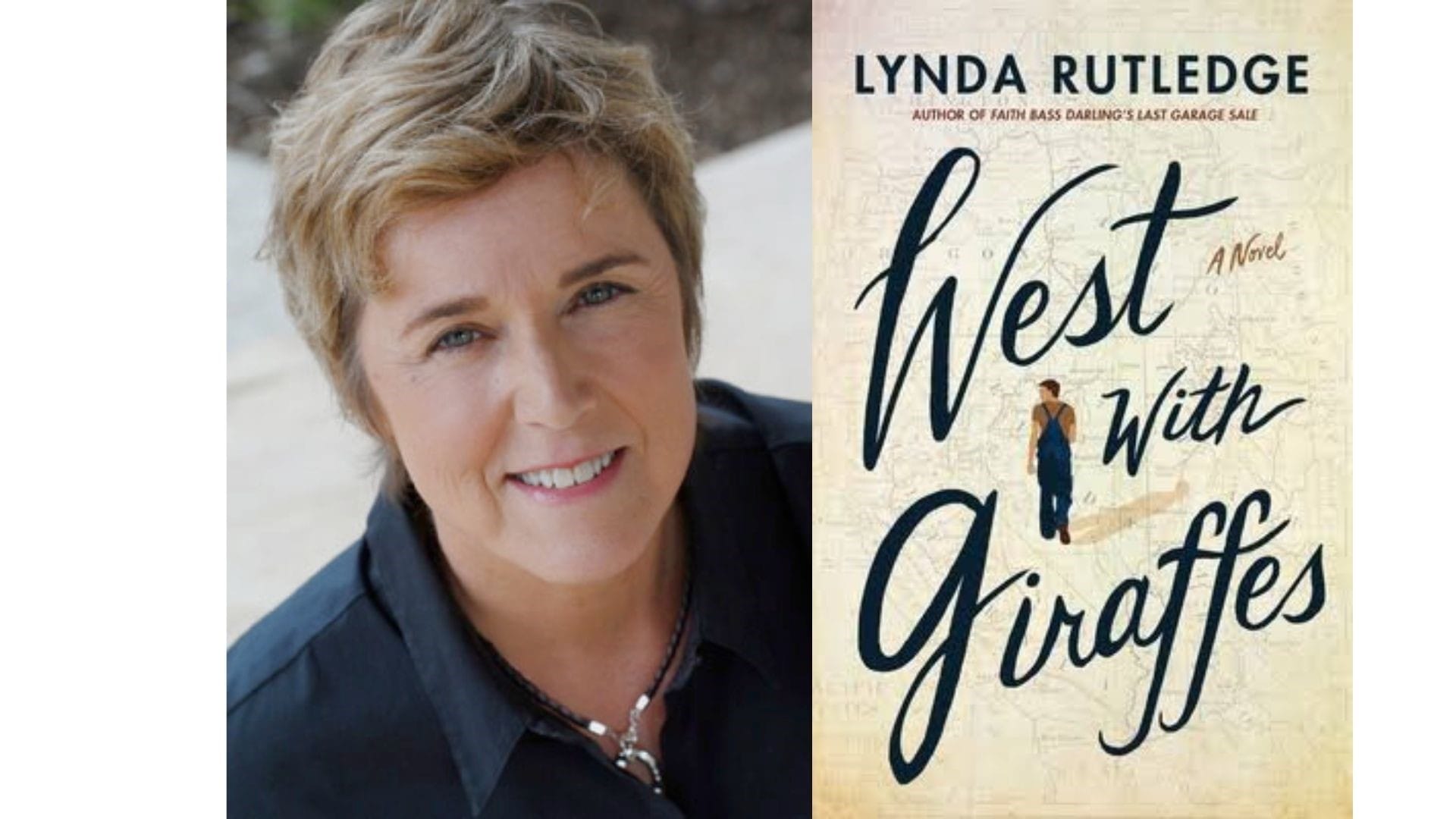
The heart of Lynda Rutledge
Lynda Rutledge doesn't disappoint. A magnificent storyteller!
Bookshop.org was created as a socially conscious alternative to Amazon, with the goal of helping local, independent bookstores thrive. This is why Readers With Wrinkles supports their efforts. Please join us in this effort by purchasing your next read here.

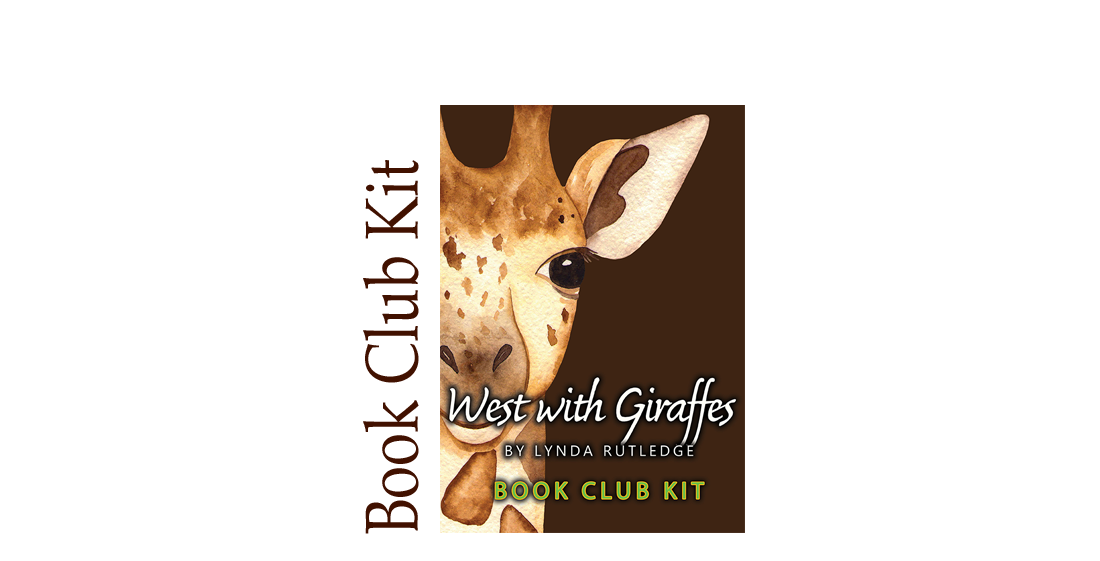
Comments